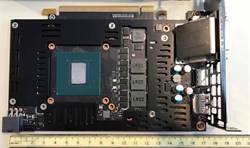Yes - correct three tests in this order (1) Stock Card with Tape, (2) Replaced TIM with Tape, (3) Replaced TIM without Tape.
I will edit the post tonight with graphs (bar graph with mean temps & line graph with temps over time) when I get home. So the delta from just replacing the TIM was ~5 °C, and the delta from replacing the TIM + Removing the tape was ~5°C .
I will also share the data to make it publically available tonight. I believe this is the most important aspect of testing, is independent verification and sharing data so we all can use it. Many tests in the PC tech community use the empirical method (really only descriptive data) whereas I am trying to make a push for open access to data and the use of the scientific method for testing.
Also - the VRM temps I do not seem to be that serious of an issue. There are thermal pads (1mm) on the VRMs and Memory covered by a black aluminum heat spreader (1mm) see pic below. You could replace the stock thermal pads with something fancier (i.e., Fujipoly Extreme XR @ 17W/mK), but anything around 6W/mK thermal pads would do just fine.

With a custom voltage curve, I can OC to +160Mhz on the clock at 1.00 V stable. I haven't pushed the card since removing the tape but will do more tinkering tonight.
Also - the best part of removing the tape isn't the improvement GPU thermals. It is improved thermals inside your case. I noticed that all of my components were noticeably cooler. (Again, you can verify with data I'll upload tonight, so looks like the video will be delayed a bit).
Attached Image(s)
